By: Melanie Maupin
Even before your favorite films hit theatres, many were first screened at film festivals.
For the past 85 years, festivals have been vital to the global film industry and popular culture at large. They have opened doors for generations of emerging artists, fulfilled dreams, heralded shifts in the kinds of stories we tell, and ushered some of our favorite films into our lives.
At its core, a film festival is a celebration of movies. Fest organizers program a slate of films, from shorts to features, and invite audiences to experience new, original works. For filmmakers, festivals often present the first opportunity to share a project years in the making with a theatre full of strangers. But the most thrilling appeal of festivals may be the allure of being discovered, going from some kid who maxed out credit cards to fund their movie to Hollywood Auteur overnight.
Time and again, we’ve learned the exposure to film distributors and influential critics that film festivals offer can, in fact, be life-changing. Many filmmakers got their first “big break” at a festival and went on to direct major studio films. Director Darren Aronofsky’s career led from Pi premiering at Sundance to making the edgy Requiem for a Dream to the Academy Award®-winning Black Swan. Marc Webb went from another Sundance hit 500 Days of Summer to The Amazing Spider-Man.
Colin Trevorrow’s film Safety Not Guaranteed won the Waldo Salt Screenwriting Award at Sundance; soon after, Trevorrow found himself directing Jurassic World. Taika Waititi’s short Two Cars, One Night won several festival awards and the Academy Award® for Best Short Film. Waititi just directed the Marvel film Thor: Ragnarok.
So how did this whole process evolve? Imagine, if you will, a time before the internet.
You’ve probably heard the Venice Film Festival mentioned in the same breath as any number of prestigious films. While it is best known for screening Best-Picture Oscar® contenders like La La Land, it also has the distinction of being the first film festival in existence, premiering in the summer of 1932. Since then, film fests have been established worldwide – from Berlin to Toronto, Cannes to New York City, Tokyo to Sydney, and quickly moved beyond major cities. Smaller towns like Winston-Salem and Telluride all hold their own in the film festival world.
As film festivals are a magnet for new filmmakers, they are also often the first stop for groundbreaking new cinema. Festivals provide artists with a venue to showcase their creativity past traditional narrative and visual boundaries, such as in 1991, when the experimental feature Poison artfully balanced three different narratives and pushed the social envelope by incorporating themes from the LGBTQ community – a daring move for the time. Poison is now considered an early milestone in the “New Queer Cinema” movement. This paved the way for future films to do the same, including 2015’s Tangerine, which bravely told the story of transgender sex workers in Los Angeles, and pushed technical norms by shooting on iPhones instead of professional cameras.
No matter how much time has passed or how many distribution model advancements film fans have embraced, film festivals remain as relevant as ever. There is perhaps no better indicator of their importance than the fact that they continue to be the place so many potential Oscar® films make their public debuts. The 2015 Best Picture winner, Spotlight, premiered at Venice. One year later, Moonlight – a Telluride film – won Best Picture. If you look at all the other nominees for Best Picture in 2016, you will find Manchester by the Sea, Lion, Hell or High Water, La La Land, Arrival, and Hacksaw Ridge all got their starts at film festivals, as well.
The grand tradition of film festivals discovering the next generation of creative voices, however, may finally be under threat. Because, while a film festival premiere can help elevate the exposure and prestige of the year’s best films, it unfortunately cannot guarantee financial success.
Even the strongest of films fall victim to rampant global piracy. Moonlight may have won Best Picture in 2016, but it also suffered severely due to the amount of theft it incurred. The film made over $65 million theatrically worldwide, which translates to over 9 million tickets sold. Yet since its release, there have been over 60 million piracy transactions. That’s more than SIX TIMES higher than the amount of paid ticket sales. If even only 5% of the pirated transactions had been paid theatrical ticket sales, the film would have earned an additional $21 million. Life or death for an independent film.
Equally important to understanding piracy’s effect on films that have been released is recognizing its effect on films that will never be made at all. The world of independent film is still a business, and investors are far less inclined to write a check if they don’t see a path to profitability. So an environment where even a Best Picture winner’s profits are gutted by piracy means untold numbers of independent films never find the financing they desperately require. Put simply, more piracy equals fewer films.
Film festivals celebrate and support this art form. But it is not the only way. We must stand united in fighting piracy to protect film as we know it. Because no festival can screen the films that almost existed.



